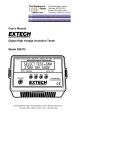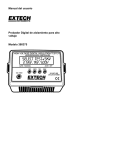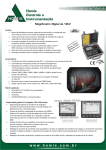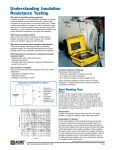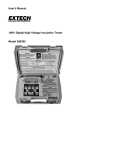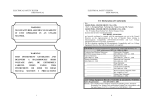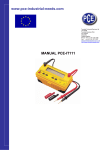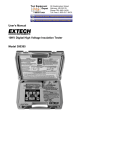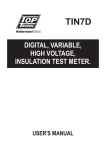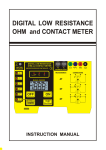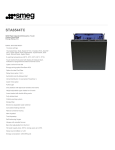Download User`s Manual Digital High Voltage Insulation Tester Model 380375
Transcript
User's Manual Digital High Voltage Insulation Tester Model 380375 Warranty EXTECH INSTRUMENTS CORPORATION warrants this instrument to be free of defects in parts and workmanship for one year from date of shipment (a six month limited warranty applies on sensors and cables). If it should become necessary to return the instrument for service during or beyond the warranty period, contact the Customer Service Department at (781) 890-7440 ext. 210 for authorization or visit our website at www.extech.com (click on Contact Extech and go to Service Department to request an RA number). A Return Authorization (RA) number must be issued before any product is returned to Extech. The sender is responsible for shipping charges, freight, insurance and proper packaging to prevent damage in transit. This warranty does not apply to defects resulting from action of the user such as misuse, improper wiring, operation outside of specification, improper maintenance or repair, or unauthorized modification. Extech specifically disclaims any implied warranties or merchantability or fitness for a specific purpose and will not be liable for any direct, indirect, incidental or consequential damages. Extech's total liability is limited to repair or replacement of the product. The warranty set forth above is inclusive and no other warranty, whether written or oral, is expressed or implied. Introduction Congratulations on your purchase of Extech’s High Voltage Insulation Tester. This device has four voltage test ranges (up to 5kV) and measures insulation resistance to 250GΩ. This professional meter, with proper care, will provide years of safe reliable service. Safety 1. Circuits under test must be de-energized and isolated before connections are made. 2. Circuit connections must not be touched during a test. 3. After insulation tests, capacitors must be discharged. 4. Test leads (including alligator clips) must be in good working order, clean and without broken or cracked insulation. 5. When servicing, use only specified replacement parts. 6. Environmental conditions: • Indoor use only; Installation category II • Pollution degree 2 • Altitude up to 2000 meters • Relative Humidity 80% max.; Temperature 0 to 40 C o International Safety Symbols Caution, refer to this manual before using this meter Dangerous Voltages; risk of electric shock Meter is protected throughout by double or reinforced insulation 2 380375 V1.5 3/04 Specifications General specifications Display 2 x 16 character alphanumeric multi-function dot matrix Range selection Automatic ranging Bargraph Displays voltage ramp, soak, and decay Automatic discharge After automatic & manual stop or upon completion of test Low battery indicator "Replace battery" displayed when battery voltage is low Power source Eight 1.5V AA cells; Battery life 40 hrs (no load at 5kV) Auto Power off After 30 minutes Enersave TM mode Shorter test time to conserve battery life o o Operating conditions 32 to 104 F (0 to 40 C); < 80% RH Storage conditions 14 to 140 F (-10 to 60 C); < 80% RH Dimensions 4.7 x 6.7 x 3.7” (120 x 170 x 95mm) Weight 1.94 lbs (880g) o o Range Specifications Test Voltage Resistance Ranges Short Circuit Current Accuracy Resolution 500V DC 0 to 25 GΩ 1mA 1000V DC 0 to 50 GΩ 1mA 0 to 50GΩ: ± 3% reading 1kΩ 2500V DC 0 to 125 GΩ 1mA 50 to 250GΩ: ± 5% reading 5000V DC 0 to 250 GΩ 1.6 mA Meter Description 1 \ 1. Test lead jacks compartment 2. Dot Matrix Display 3. Voltage test buttons 4. ON / TEST button 5. Battery compartment is located on bottom of unit 2 3 4 5 3 380375 V1.5 3/04 Operation Note: Ensure that the circuit under test does not include devices or components that can be damaged by 5000VDC; such devices include power factor correction capacitors, low voltage mineral insulated cables, electronic light dimmers, ballasts and starters for fluorescent lamps. Connecting the Test Leads to the meter The Black (Earth) and Red (Line) test leads connect to the meter in the lead compartment located on the back of the meter (the meter jacks are color coded). NOTE: The Green (Guard) lead is typically not used. Do not connect this test lead to the meter unless absolutely certain it is going to be used. For more information, continue reading this Operation section and the Applications section to follow. Connecting the Test Leads to the device under test The Black (Earth) lead is connected to the conductive material. The Red (Line) lead is connected to the insulating material. The Green (Guard) lead is at the same potential as the negative terminal (0V) and, when required, is used to prevent erroneous readings by removing parallel leakage paths from the measurement. Insulation Resistance Measurements 1. Connect the test leads to the meter and the device under test. 2. Press the ON / TEST button to turn the unit on. The unit will display the turn-on screens and then stop at the “Select Test” display. 3. Select the desired test voltage by pressing the 500V, 1KV, 2.5KV, or 5KV button. The screen will briefly Connect Leads display the selected test voltage and then will proceed Testing for LIVE to the “Connect Leads Testing for LIVE” display. If the circuit is “live” the display will indicate “Live Warning… Circuit Live” and the meter will beep. If this occurs, remove the test leads and press the ON / TEST button. 4. Press the ON / TEST button to apply the voltage and begin the test. The meter will beep every 2 seconds which indicated high voltage is on the test leads and the meter will intermittently buzz while the high voltage is being generated. 5. On the display, elapsed test time appears on the upper right, the resistance reading appears on the upper left, the selected voltage is shown on the lower right and the bar graph indicates the actual voltage present on the test leads. R= 108.2MΩ 0 ██████ 6.5s 500V 6. At the completion of the test the meter will discharge R= 128.4MΩ the device under test and the display “HOLD”. Do not 0 HOLD remove the test leads until the bargraph disappears (complete discharge) and “HOLD” appears in the display. 7.4s 500V 7. The meter automatically discharges the system at the end of the test. The test ends when one of the following occurs. Select Test 2.5kV, 1kV, TM mode. a. After approximately 10 seconds in the Enersave b. After approximately 100 seconds in the continuous mode. c. When the red ON / TEST button is pressed. 4 5kV 500V 380375 V1.5 3/04 TM The Enersave Mode TM Enersave conserves battery life by reducing the test time from 100 seconds to approx. TM TM 10 seconds. Enersave is the default mode of operation. To disable Enersave press and hold the ON / TEST button for three seconds to begin a test. Bargraph Voltage Display The bargraph represents the voltage present on the test leads as it charges, soaks, and discharges. The bargraph appears on the lower portion of the display during tests. Automatic Low Resistance Detect If the display shows the message “LOW MΩ”, the test should be interrupted immediately by pressing the ON / TEST button. This message indicates that the insulation under test has broken down and the meter is trying to inject a high potential onto a short circuit. Elapsed Timer The test duration is indicated on the display. This is particularly useful in determining whether an insulating material under test will break down in a given amount of time. Manual Test STOP To stop a test in progress, press the ON / TEST button. The test will immediately end and the system will automatically discharge. Automatic Test STOP TM The test automatically stops after 100 seconds if the meter is not in the Enersave mode. TM When in the Enersave mode, the test automatically stops after approx. 10 seconds. Live Circuit Warning If the test leads are connected to a live circuit when testing, a warning beeper will sound and the meter will display “Live Warning…Circuit Live…”. In this case, correct the problem and retest. Automatic Discharge At the end of a test, the meter automatically discharges the high voltage. The automatic discharge status is reflected on the display. During discharge the beeper will sound and, when completely discharged, the HOLD icon appears on the display. Auto OFF The meter will automatically turn off after approximately 30 minutes of operation. 5 380375 V1.5 3/04 Applications Measuring Power Tools and Small Appliances For small appliances, connect the Black (EARTH) lead to conductors and the Red (LINE) lead to insulating material. For single or double insulated power tools, one lead should be connected to the device’s chuck, blade, etc. and the other lead to one of the AC power cord conductors (test both conductors in turn). Refer to the power tool application diagram below. AC Plug For 2 or 3 prong plugs, connect the RED lead to one conductor at a time Connect the BLACK lead to the chuck Testing Motors AC Motors Connect BLACK lead Disconnect the motor from the line by: to the motor leads a. Disconnecting the wires from the motor terminals or Connect RED lead b. Opening the main switch to grounded housing If the main switch is opened, and the motor also has a motor-starter, then the starter must be held in the ON position. With the main switch opened, the measured resistance will include the resistance of the motor wire and all other components between the motor and the main switch. If a weakness is indicated, the motor and other components should be checked individually. If the motor is disconnected at the motor terminals, connect the RED lead to the grounded motor housing and the BLACK lead to one of the motor leads. DC Motors 1. Disconnect the motor from the line. 2. To test the brush rigging, field coils and armature, connect the RED lead to the grounded motor housing and the BLACK lead to the brush on the commutator. 3. If the resistance measurement indicates a weakness, raise the brushes off of the commutator and separately test the armature, field coils and brush rigging by connecting one lead to each individually, leaving the other connected to the grounded motor housing. This also applies to DC Generators. Testing Single Conductor Cables 1. Completely disconnect the cable under test from its source and destination. 2. Connect the test leads to the cable as shown at right. Core EARTH 6 Insulation Sheath GUARD Covering LINE 380375 V1.5 3/04 Testing Multi Conductor Cables 1. Completely disconnect the cable under test from its source and destination. 2. Refer to the diagrams at right for three possible tests. EARTH Testing one conductor to all of the conductors LINE EARTH Testing one conductor to earth LINE GUARD GUARD Testing one conductor to all conductors minus ground LINE EARTH Transformer Testing Transformer tests are performed with the transformer completely disconnected from the line and the load. Note that the case ground should not be removed. The five tests listed below will completely test a single-phase transformer. Note that at least 1 minute should be allowed between each test. 1. 2. 3. 4. 5. High voltage winding to low voltage winding and ground Low voltage winding to high voltage winding and ground High voltage winding to low voltage winding (pictured below) High voltage winding to ground Low voltage winding to ground Connect the BLACK lead here Connect the RED lead here 7 380375 V1.5 3/04 Maintenance Battery Replacement When ‘REPLACE BATTERY’ appears on the display, replace the eight 1.5V ‘AA’ batteries. 1. Ensure that the meter is powered down and that the test leads are not connected 2. Close the instrument cover and turn the instrument upside down 3. Remove the phillips head screw located on the bottom of the meter 4. Remove the battery compartment cover 5. Replace the eight batteries ensuring proper polarity 6. Affix the rear cover and secure the rear screw Cleaning Periodically wipe the case with a dry cloth. Do not use solvents or abrasives to clean this instrument. Repair and Calibration Extech offers complete repair and calibration services for all of the products we sell. For periodic calibration, NIST certification or repair of any Extech product, call customer service for details on services available. Extech recommends that calibration be performed on an annual basis to insure calibration integrity. Support Hotline (781) 890-7440 Tech support: Ext. 200; Email: [email protected] Repair/Returns: Ext. 210; Email: [email protected] Website: www.extech.com Copyright © 2002 Extech Instruments Corporation. All rights reserved including the right of reproduction in whole or in part in any form. 8 380375 V1.5 3/04








